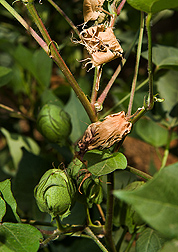This page has been archived and is being provided for reference purposes only. The page is no longer being updated, and therefore, links on the page may be invalid.
Read the magazine story to find out more. |
|
|
Breeding Cotton to Beat the Heat
By Laura McGinnisFebruary 5, 2008
People expect a lot from cotton.
Consumers want durable, comfortable fabrics. Producers want easy-to-manufacture textiles. And growers want hardy, thriving plants. Uniting these traits is the goal of Agricultural Research Service (ARS) cotton breeders at the U.S. Arid-Land Agricultural Research Center in Maricopa, Ariz.
Plant geneticist Richard Percy, now with the ARS Southern Plains Agricultural Research Center in College Station, Texas, has bred new cotton lines with qualities to please growers, fabric manufacturers and consumers.
Pima—an extra-long-staple cotton—produces long, strong fibers that are suitable for high- quality products such as luxury bed sheets and sewing thread. But pima plants have been historically susceptible to heat. They start exhibiting symptoms of heat stress when their leaf canopy temperature—the temperature of a plant itself, as opposed to the air around it—reaches about 82 degrees Fahrenheit.
During the past five decades, Percy and his colleagues have bred and released heat-tolerant and heat-avoidant pima lines, which the commercial seed industry has used to create new varieties that can withstand extreme temperatures.
In 2003, Cotton Incorporated offered to partner with Percy and ARS to improve heat tolerance and fiber quality in upland cotton, the species that makes up the majority of the U.S. cotton crop. To ensure that the new cotton lines would be productive and competitive throughout the Cotton Belt, Percy enlisted ARS and university scientists in Georgia, South Carolina, Louisiana and California in an across-the-cotton-belt breeding and evaluation program.
In 2006, as a result of their collaboration, ARS and Cotton Incorporated released three upland cotton lines with superior fiber quality and heat tolerance. Those lines have been picked up by about two dozen commercial seed companies and breeders for further development.
Read more about this research in the February 2008 issue of Agricultural Research magazine.
ARS is the U.S. Department of Agriculture's chief in-house scientific research agency.

